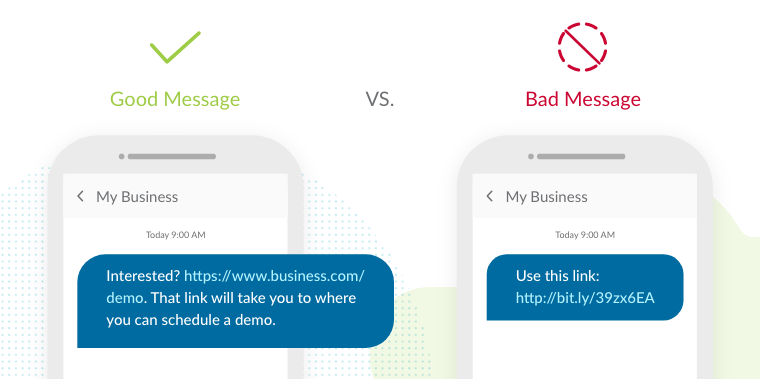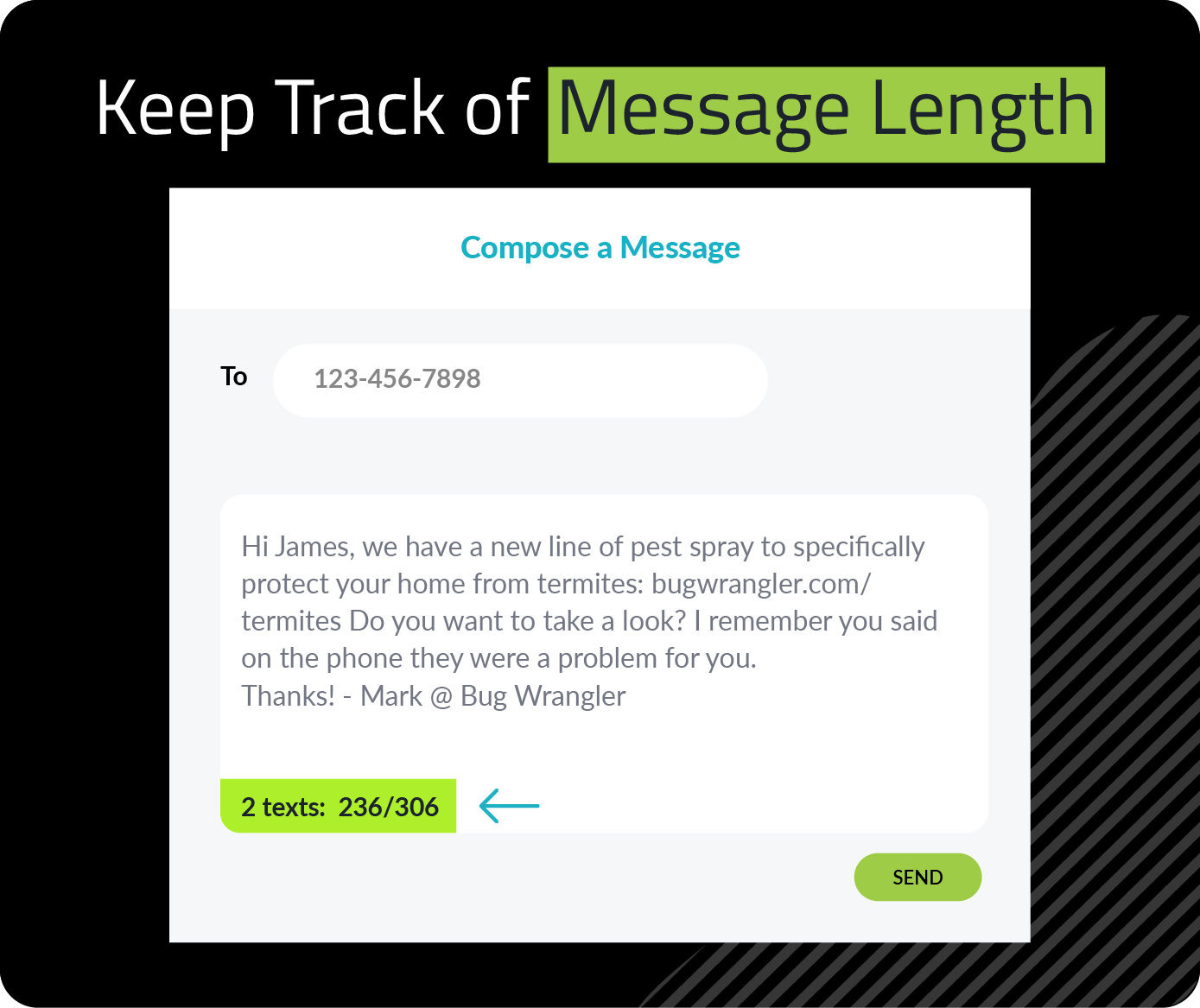It can be tempting to take advantage of text message marketing and the direct line to your audience. But spamming your customers can be counterproductive.
- Text message spam includes texts designed to sell consumers unwanted products or to steal their personal information.
- Sending spam text messages can damage your business’s reputation and lead to significant fines.
- By following proper business texting etiquette, you can prevent legal issues and maintain a strong relationship with your customers.
- This article is for business owners who want to employ text message marketing without spamming their customers.
Business texting, or when a company sends bulk messages to customers who have opted in to receive them, can be a highly effective way to reach your audience. Also called SMS marketing, MMS marketing or text message marketing, this method of casual communication has better engagement rates than other channels, including email and social media: On average, it takes a person less than two minutes to respond to a text, compared with nearly two hours for email, according to Campaign Monitor.
However, text message marketing also comes with some risks, and it’s important to follow texting etiquette to avoid tarnishing your business’s reputation. If you want your customers to be engaged, they cannot interpret your text messages as spam. Follow these best practices for implementing an effective text message marketing campaign that doesn’t spam your audience.
What is considered a spam text message?
Spam texts include several types of junk mail, either designed to sell customers unwanted products or to steal their data, passwords and personal information.
In common business practices, spam text messaging includes texting company marketing without the consumer’s consent, sending multiple texts at one time, using group texts and employing multiple forms of communication for the same call to action (CTA) – for example, calling or emailing a customer and then sending a text with the same information.
The more malicious type of spam texts come in the form of phishing or “smishing.” These text messages are attempts to collect a customer’s data by posing as a business, friend or family member. Recipients could risk a data breach by engaging with these messages.
Sending text messages with consent
To send text messages to customers, you must get their consent. If you have an established relationship with a consumer, you could obtain that customer’s consent to send transactional text messages, such as company updates, appointment reminders and payments. Requesting that customers double opt in to text messages can cover the consent requirement and ensure open communication between your business and your customers.
It is illegal to promote the following business categories via text message in any capacity:
- Alcohol
- Firearms
- Illegal drugs
- Pornography
- Tobacco
Key Takeaway
Always get consent from the customer before sending any text message marketing.
Examples of spam text messages
Text messages can appear as spam if they are filled with typos or grammatical errors. Consumers may also interpret text messages as spam if they are impersonal with simple greetings, create a sense of urgency or provide an offer that is too good to be true. Avoid sending texts relating to the following topics, which your customers may confuse with spam:
Free money
- Winning a contest not related to your business
- IRS
- Refund notifications
- Free bitcoin
- Credit card offers
- Package delivery not related to your business
Personal account numbers
- Verification of a bank account
- Compromised login credentials
Friend or family member
- Financial assistance requests
- Help with student loans
Tip
Proofread and personalize your text messages to exude trust and professionalism.
What are the legal consequences of spam text messages?
Depending on the type and number of spam text messages a sender distributes, there could be significant legal consequences for spam text messaging. Consumers can report spam through apps, mobile service providers and the Federal Trade Commission (FTC). If messages continue after a consumer has blocked and reported them, businesses could be liable for hefty fines on a per-message basis.
Did You Know?
Sending spam text messages can damage your business’s reputation and lead to significant fines.
What actions can a consumer take for spam text messages?
A customer can easily filter and block messages from unknown senders through Android and iOS. They can also seek spam blockers via their wireless provider or a third-party app. According to the FTC, consumers can report spam in two ways:
- Use the FTC mobile messaging app.
- Copy the spam text messages and send them to 7726 (SPAM).
If consumers still receive spam texts after blocking and reporting measures have been taken, they can file a civil lawsuit under federal telemarketing law.
Consumers are protected under the Telephone Consumer Protection Act of 1991 (TCPA), which was initially enacted for unwanted phone solicitation but has since been expanded to include consumer consent to companies participating in robocalls and text messaging.
Under the TCPA, consumers can sue companies (for example, see the 2009 case of Satterfield v. Simon & Schuster Inc.) for damages of up to $500 to $1,500 per spam text message.
Key Takeaway
Under the TCPA, consumers can block, report and sue companies that send spam text messages.
How to avoid sending spam text messages to customers
These 10 text message marketing tips can help you improve the quality of your texts, thus boosting their effectiveness without sacrificing customer satisfaction:
1. Be upfront.
Introduce yourself or your company in the initial text message. Chances are, your phone number isn’t in their contact list, so don’t leave them guessing. Customers want to know what kind of text messages they should expect to receive from you.
If you offer multiple message types, consider providing an opt-in form that allows the customer to choose which content they can receive and offers a courteous way of asking permission. Dividing your list into segments will help you target the right customers.
2. Consider your audience.
A casual tone invites the customer into the conversation while being direct. It’s fine to use well-known abbreviations and emojis, but do so sparingly. Consider your target audience’s age, location, interests, needs and so on. Avoid vague or confusing messages.
3. Personalize each message.
Use a text messaging platform to personalize the text to each customer. Always proofread each message before you send it.
4. Create a clear call to action.
When you are requesting an action from your customer, always include detailed information in the text. If a customer needs to pick up an order, let them know when it will be available and the best way to retrieve their items. Other possible CTAs include requests for a product review, discount codes, and timely sale notifications.
If you send a CTA in a text, do not use that same CTA to send an email or phone call. Using multiple channels to get your point across can annoy customers and cause unnecessary message overload.
5. Keep URLs short.
Getting a text with an overly long URL is a nuisance. Long URLs look unprofessional, so run your URL through a shortener service, like Bit.ly, before inserting it into a text.
6. Respond quickly and concisely.
Because a text message doesn’t interfere with your customer’s schedule as a phone call could, there shouldn’t be any wait time in your response. Customers should feel like you care about their business.
However, if your response time isn’t within the hours of 9 a.m. and 6 p.m., wait until the next business day. The only exception to this rule would be if the customer texts you during off-hours first. If you automate your text messages, also stick to business hours unless it makes sense to deviate. For example, if you are a restaurant, you can send a text during the hours your customers would normally be eating lunch or dinner.
7. Limit your texts to 160 characters.
If the conversation gets complicated, consider using a different means of communication. Texting multiple paragraphs can confuse the customer and make it hard for them to take action.
Texts longer than 160 characters may get split into multiple texts and arrive in your customer’s inbox in the wrong order. Plus, multiple messages create multiple notifications, which can be annoying to your audience.
8. Skip confidential information.
Sending personal information through text can leave you open to liability. Always use an encryption service platform, like Signal, to send and receive confidential information.
9. Limit the number of texts you send.
If you want to increase leads or encourage customers to purchase again, don’t spam them with repetitive texts. Keep alerts to a minimum.
10. Always offer a way out.
Whether you are texting a potential lead or a longtime customer, sometimes the customer needs to stop receiving your promotional messages. Follow TCPA guidelines, and offer an easy opt-out (“text STOP to stop receiving these messages”) to avoid legal issues.
Tip
Follow business texting etiquette to prevent legal issues and maintain a strong relationship with your customers.
11. Share links that haven’t been shortened.
Shortened links will almost always trigger spam filters. It’s in your best interest to avoid them, unless you have a custom-branded short domain.
Carriers will also get suspicious if you send a link to more than 50 people at a time, so we recommend spacing messages with links out.
Good: “Interested? https://www.business.com/demo That link will take you to where you can schedule a demo.”
Vs.
Bad: “Use this link: https://bit.ly/39zx6EA”
That said, unreasonably long links will also trigger spam filters, so avoid sharing ones that look like:
“https://www.google.com/maps/dir/35.047214,-85.303271/google+map+to+chili’s/@35.0495358,-85.3111895,16z/data=!3m1!4b1!4m9!4m8!1m

12. Place your links in between words.
Surround your links with an explanation of where you’re sending the customer. That way both carriers and customers know you aren’t taking them somewhere dangerous.
Good: “We have a guide for that: https://www.textrequest.com/insights/10dlc That link will walk you through registration.”
Vs.
Bad: “Use this article: https://bit.ly/3FUU6tF”
13. Avoid sending naked links.
A naked link is one without the “https://www.” Always include that first portion of your link to avoid triggering spam filters.
We don’t fully understand why naked links bother carriers—but cover em’ up just to be safe.
Mobile carriers care a lot about security and protecting their consumers, so we assume having “https://www.” shows you link to a secured site and are less likely to be a spammer.
14. Don’t include ALL CAPS anywhere in your message.
Customers don’t respond well to ALL CAPS, but more importantly ALL CAPS are typical of spammers trying to get people’s attention and create urgency. We recommend avoiding them in both your mass and individual messages.
Good: “We have new exclusive content ready for our SMS subscribers like you: https://www.business.com/sms-rewards Use that link to claim your VIP rewards!”
Vs.
Bad: “EXCLUSIVE DEAL here: https://www.business.com/sms-rewards DON’T miss out!”
You can get your point across and create excitement without using ALL CAPS in your texts. Check out our 15 SMS marketing ideas to help you do just that.
15. Limit your use of special characters.
Special characters—anything that isn’t a letter or number—and emojis are great for one-on-one conversations, but larger Mass Texts including these characters will get the carrier’s attention. Dollar signs in particular have a high chance of triggering spam filters.
Good: “New seasonal discount on tuneups: https://www.business.com/tuneups Schedule your appointment using that link.”
Vs.
Bad: “Tuneup time! 🔔 Schedule now and save $$$.”
16. Keep your messages varied and personalized.
Messages catered to individual customers will bring them the most value. Sending the same exact message to large groups over and over again will make carriers suspicious.
Our Merge Fields feature makes it easy to personalize messages at scale.
Good: “Hi [Name], your last tuneup was [date]. Would you like to schedule another one to keep your system running smoothly?”
Vs.
Bad: “You’re due for a tuneup.”
We also recommend formally planning and spacing your messages out, so you don’t annoy your customers and attract the eyes of carriers.

17. Keep your messages short and sweet.
You’re sending a text for a reason. Keep your messages around one to two sentences.
If your text is the size of an email, carriers are going to stop you. Your customers are also more likely to engage with messages that are on the shorter side.
Good: “We have a case study that shows how we’ve helped businesses similar to yours: [link] Let me know if you’d like to schedule a call to learn more.”
Vs.
Bad: “We have a case study that tells the story of how we helped a small business increase their HVAC sales up to 30% after they implemented our sales tactics and used our customer guides. If you read it, you’ll see that you have a lot in common: [link] Sound like a good fit? We’re always here if you want to talk more or schedule a call. Our mission is to help you make the biggest impact possible, and we’ve been successfully helping businesses do that since 2013.”
If the information you need to share is super detailed, redirect the conversation to a link or scheduled phone call instead.

18. Create messages that sound like an actual human wrote them.
Atypical sentence structure, grammatical errors, and misspellings are the biggest indicator of spam. If your sentences are filled with typos, or sound like they were created by a wonky A.I., carriers will block you.
Good: “Thanks for choosing [business]! How can our reps help?”
Vs.
Bad: “Thanks for chosing us today to help with your needs. send us you name and current issue and rep will get back soon”
Proofing your texts before you send them is a must. We recommend reading your messages aloud to yourself before you hit send.